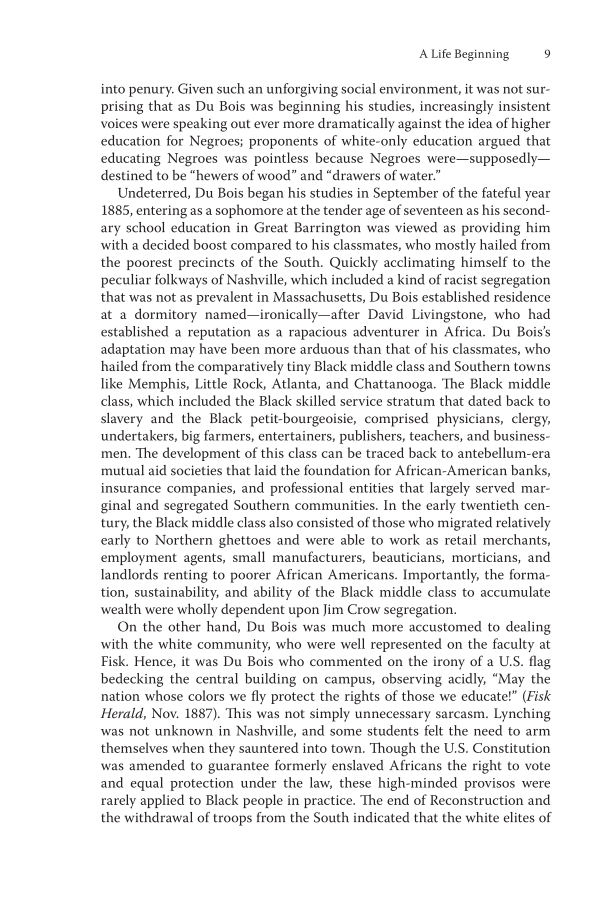A Life Beginning 9 into penury. Given such an unforgiving social environment, it was not sur- prising that as Du Bois was beginning his studies, increasingly insistent voices were speaking out ever more dramatically against the idea of higher education for Negroes proponents of white-only education argued that educating Negroes was pointless because Negroes were—supposedly— destined to be “hewers of wood” and “drawers of water.” Undeterred, Du Bois began his studies in September of the fateful year 1885, entering as a sophomore at the tender age of seventeen as his second- ary school education in Great Barrington was viewed as providing him with a decided boost compared to his classmates, who mostly hailed from the poorest precincts of the South. Quickly acclimating himself to the peculiar folkways of Nashville, which included a kind of racist segregation that was not as prevalent in Massachusetts, Du Bois established residence at a dormitory named—ironically—after David Livingstone, who had established a reputation as a rapacious adventurer in Africa. Du Bois’s adaptation may have been more arduous than that of his classmates, who hailed from the comparatively tiny Black middle class and Southern towns like Memphis, Little Rock, Atlanta, and Chattanooga. The Black middle class, which included the Black skilled service stratum that dated back to slavery and the Black petit-bourgeoisie, comprised physicians, clergy, undertakers, big farmers, entertainers, publishers, teachers, and business- men. The development of this class can be traced back to antebellum-era mutual aid societies that laid the foundation for African-American banks, insurance companies, and professional entities that largely served mar- ginal and segregated Southern communities. In the early twentieth cen- tury, the Black middle class also consisted of those who migrated relatively early to Northern ghettoes and were able to work as retail merchants, employment agents, small manufacturers, beauticians, morticians, and landlords renting to poorer African Americans. Importantly, the forma- tion, sustainability, and ability of the Black middle class to accumulate wealth were wholly dependent upon Jim Crow segregation. On the other hand, Du Bois was much more accustomed to dealing with the white community, who were well represented on the faculty at Fisk. Hence, it was Du Bois who commented on the irony of a U.S. flag bedecking the central building on campus, observing acidly, “May the nation whose colors we fly protect the rights of those we educate!” (Fisk Herald, Nov. 1887). This was not simply unnecessary sarcasm. Lynching was not unknown in Nashville, and some students felt the need to arm themselves when they sauntered into town. Though the U.S. Constitution was amended to guarantee formerly enslaved Africans the right to vote and equal protection under the law, these high-minded provisos were rarely applied to Black people in practice. The end of Reconstruction and the withdrawal of troops from the South indicated that the white elites of
Document Details My Account Print multiple pages
Print
You have printed 0 times in the last 24 hours.
Your print count will reset on at .
You may print 0 more time(s) before then.
You may print a maximum of 0 pages at a time.














































































































































































































































































